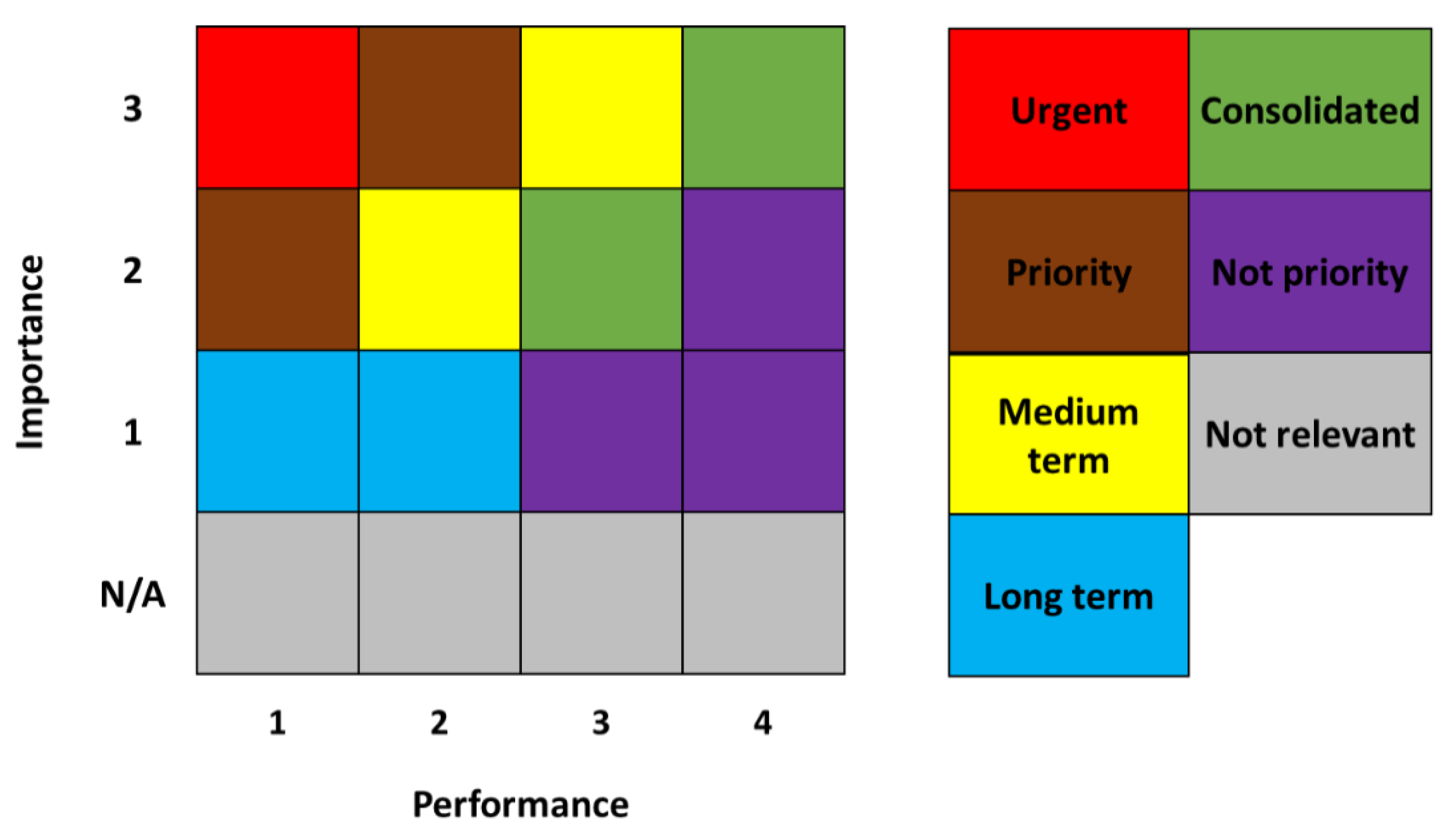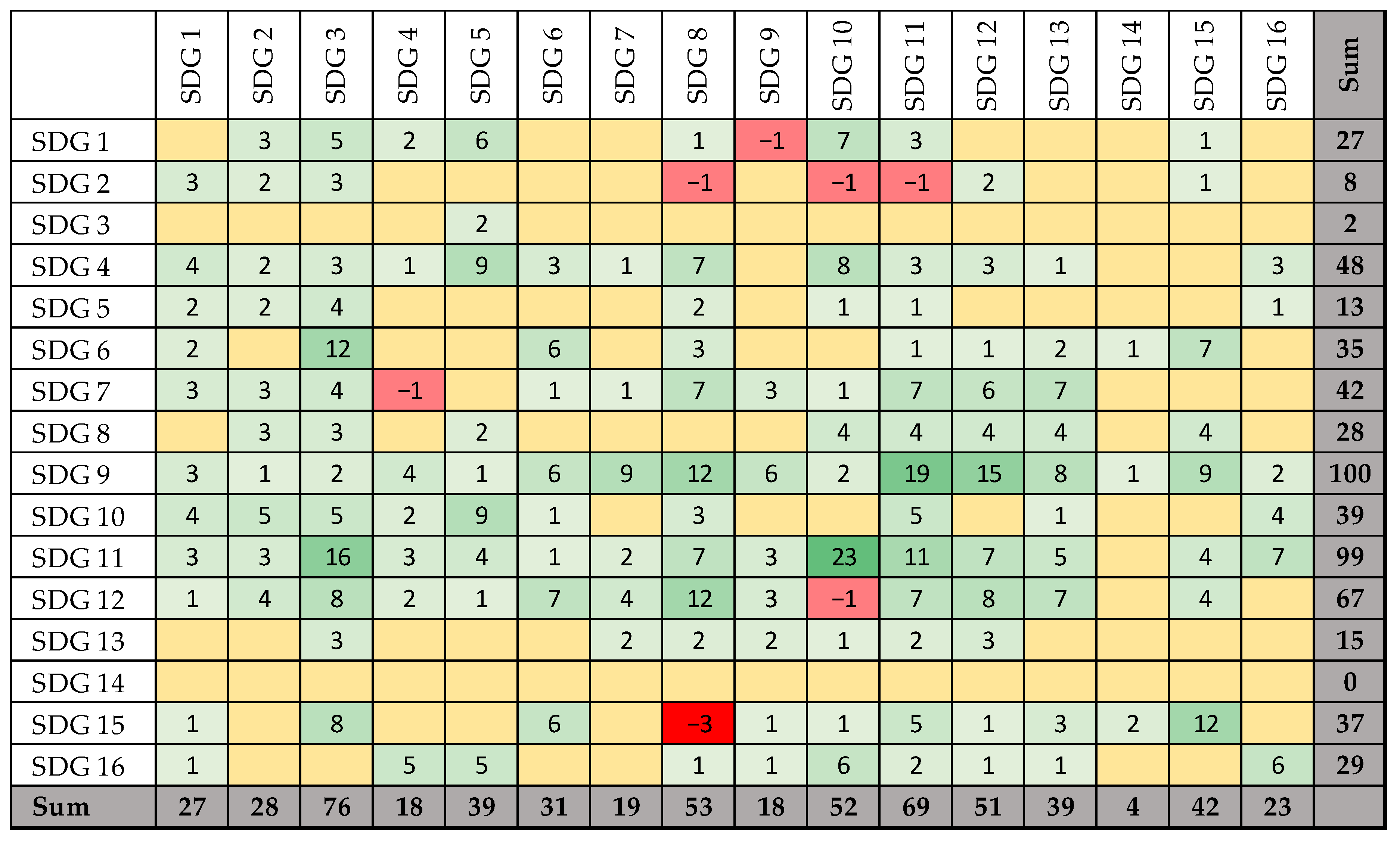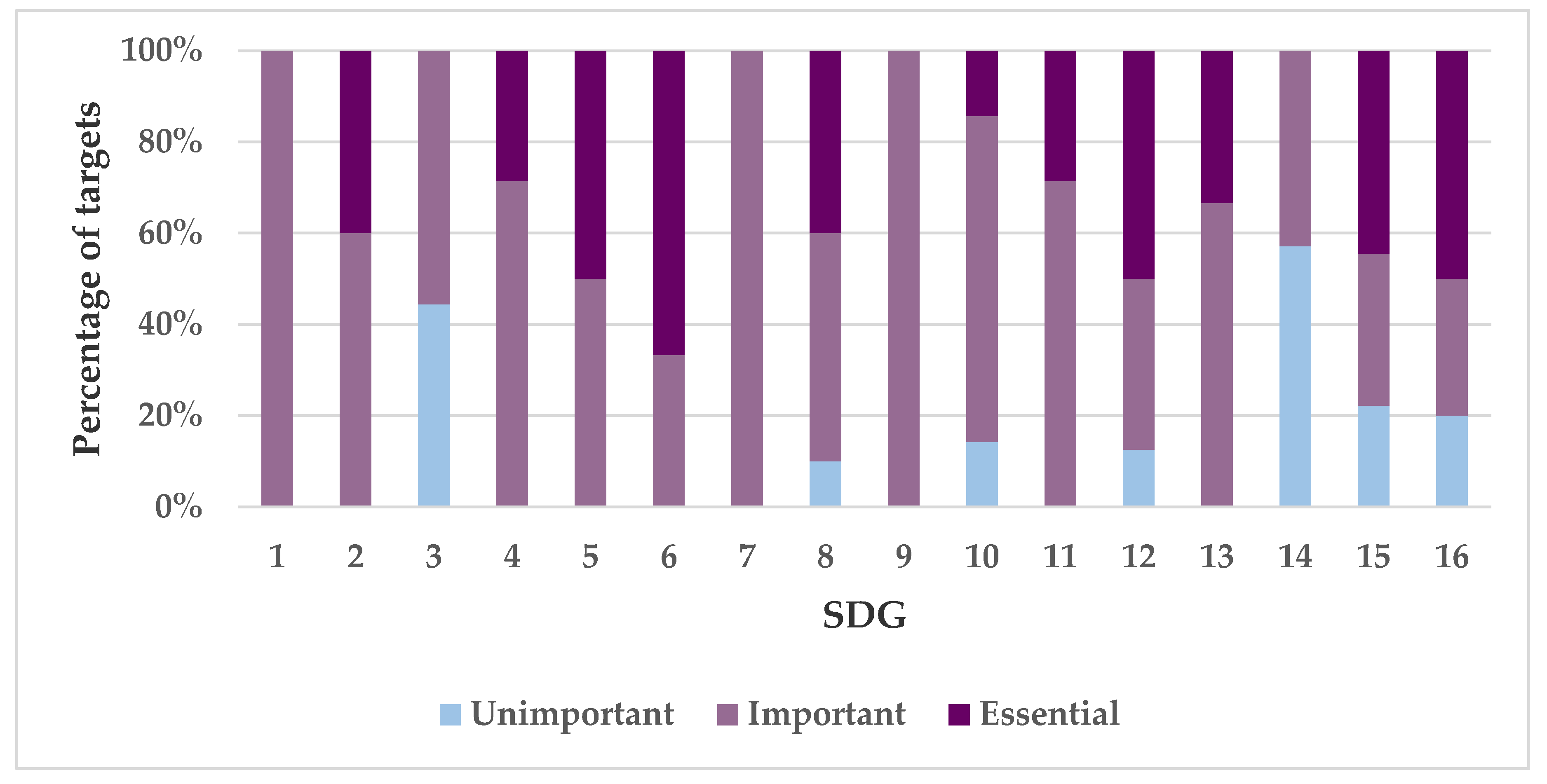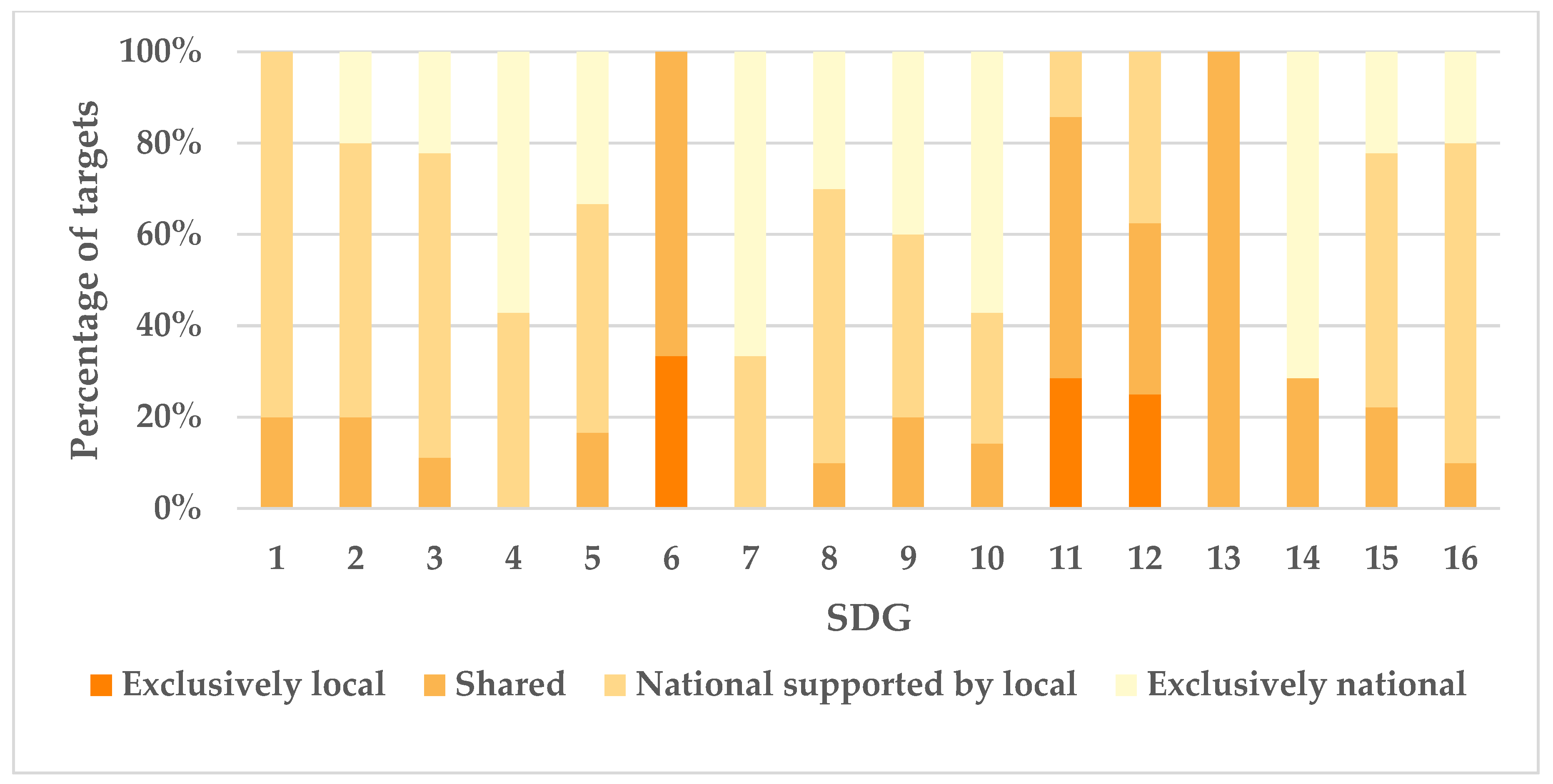A Systemic Approach for Sustainability Implementation Planning at the Local Level by SDG Target Prioritization: The Case of Quebec City
Abstract
:1. Introduction
- Level of urgency: identifying historical trends and comparing current baseline values against global benchmarks;
- Systemic impact: identifying interlinkages between SDG targets, evaluated against a semi-quantitative cross-impact matrix assessment and network analysis;
- Policy gap: assessing how SDGs align with existing strategies.
- Applicability: evaluating the relevance of the goal/target;
- Implementability: assessing the reality of attaining the goal/target within the time frame;
- Transformationalism: determining whether the achievement of the goal/target requires new and additional policies beyond those currently in place.
- Targets should be relevant and achievable;
- Targets should correspond to local government mandates;
- Priorities should be established on the basis of development gaps.
2. Materials and Methods
- Performance: Relying on SDG target indicators, what is the current level of achievement of the targets?
- Importance: Given the specific context of the city, what is the significance level of the targets?
- Governance: Knowing the constitutional division of powers, what level of governance (from national to local) holds the power and responsibilities associated with the targets?
2.1. Mobilization and Capacity Building
- Understand the concepts of sustainable development;
- Become familiar with the 2030 Agenda and the SDGs;
- Understand systemic sustainability analysis;
- Share practices between city services;
- Identify potential synergies and trade-offs;
- Prepare the prioritization activity;
- Produce and validate proposals for the sustainable development strategy.
2.2. Diagnosis–Performance
- Identify already-implemented SD initiatives;
- Align the identified SD initiatives with SDG targets;
- Assess the potential achievement of the SDG targets (document the performance criteria of the SDGT-PG).
- The target was not at all achieved;
- The target was partially achieved: there is much room for improvement, although some results are visible;
- The target is in the process of being achieved: improvements remain possible;
- The target has been achieved.
2.3. Identification of Synergies and Trade-Offs
2.4. Importance and Prioritization
2.5. Governance
- Exclusive responsibility of the local level. The local level has complete authority to act on this target.
- Responsibility shared between the local and national levels. The local level has a certain authority to act on this target; however, these competencies are also shared with the national level.
- National-level responsibility supported by the local level. The national level has the main responsibilities necessary to act on this target; however, it can delegate to the local level for implementing an action. The local level has a certain authority for ensuring action on the ground, but it does not hold decision-making power.
- Exclusive national-level responsibility. The national level has the full authority to act on this target. The local level does not have the authority to intervene, although it can sometimes influence priorities through representations at the national level.
2.6. Localization
3. Results
3.1. Performance Assessment
3.2. Synergies and Trade-Offs
3.3. Importance, Prioritization, and Governance
4. Discussion
4.1. Obstacles, Limitations, and Challenges of SDG Localization
4.2. Opportunities
5. Conclusions
Supplementary Materials
Author Contributions
Funding
Institutional Review Board Statement
Informed Consent Statement
Data Availability Statement
Acknowledgments
Conflicts of Interest
References
- United Nations. Transforming Our World: The 2030 Agenda for Sustainable Development; Resolution Adopted by the General Assembly on 25 September 2015. (A/RES/70/1). 2015. Available online: http://www.un.org/ga/search/view_doc.asp?symbol=A/RES/70/1&Lang=E (accessed on 8 December 2016).
- Allen, C.; Reid, M.; Thwaites, J.; Glover, R.; Kestin, T. Assessing national progress and priorities for the Sustainable Development Goals (SDGs): Experience from Australia. Sustain. Sci. 2020, 15, 521–538. [Google Scholar] [CrossRef]
- Krellenberg, K.; Bergsträßer, H.; Bykova, D.; Kress, N.; Tyndall, K. Urban sustainability strategies guided by the SDGs-A tale of four cities. Sustainability 2019, 11, 1116. [Google Scholar] [CrossRef] [Green Version]
- Zinkernagel, R.; Evans, J.; Neij, L. Applying the SDGs to cities: Business as usual or a new dawn? Sustainability 2018, 10, 3201. [Google Scholar] [CrossRef] [Green Version]
- United Nations Development Programme. A Multi-Dimensional Focus for the 2030 Agenda; United Nations Development Programme: New York, NY, USA, 2017; p. 14. [Google Scholar]
- Kanuri, C.; Revi, A.; Espey, J.; Kuhle, H. Getting Started with the SDGs in Cities: A Guide for Stakeholders; Sustainable Development Solutions Network: New York, NY, USA, 2016; p. 110. [Google Scholar]
- Graute, U. Local Authorities Acting Globally for Sustainable Development. Reg. Stud. 2016, 50, 1931–1942. [Google Scholar] [CrossRef]
- Kharrazi, A.; Qin, H.; Zhang, Y. Urban big data and sustainable development goals: Challenges and opportunities. Sustainability 2016, 8, 1293. [Google Scholar] [CrossRef] [Green Version]
- Klopp, J.M.; Petretta, D.L. The urban sustainable development goal: Indicators, complexity and the politics of measuring cities. Cities 2017, 63, 92–97. [Google Scholar] [CrossRef]
- United Nations; Department of Economic and Social Affairs; Population Division. World Urbanization Prospects: The 2018 Revision; United Nations: New York, NY, USA, 2019; p. 126. [Google Scholar]
- Fenton, P.; Gustafsson, S. Moving from high-level words to local action—Governance for urban sustainability in municipalities. Curr. Opin. Environ. Sustain. 2017, 26–27, 129–133. [Google Scholar] [CrossRef]
- Hoornweg, D.; Hosseini, M.; Kennedy, C.; Behdadi, A. An urban approach to planetary boundaries. Ambio 2016, 45, 567–580. [Google Scholar] [CrossRef] [PubMed] [Green Version]
- Parnell, S. Defining a Global Urban Development Agenda. World Dev. 2016, 78, 529–540. [Google Scholar] [CrossRef]
- Gustafsson, S.; Ivner, J. Implementing the Global Sustainable Goals (SDGs) into Municipal Strategies Applying an Integrated Approach. In Handbook of Sustainability Science and Research; Leal Filho, W., Ed.; Springer International Publishing: Cham, Switzerland, 2018; pp. 301–316. [Google Scholar] [CrossRef] [Green Version]
- Tremblay, D.; Fortier, F.; Boucher, J.-F.; Riffon, O.; Villeneuve, C. Sustainable development goal interactions: An analysis based on the five pillars of the 2030 agenda. Sustain. Dev. 2020, 28, 1584–1596. [Google Scholar] [CrossRef]
- United Nations Development Programme; UN-Habitat; GTF of Local and Regional Governments. Localizing the Post-2015 Development Agenda- Dialogues on Implementation; United Nations: New York, NY, USA, 2015. [Google Scholar]
- Riffon, O. Une typologie pour l’analyse des représentations du développement durable des instruments de mise en oeuvre à l’échelle territoriale. In Les Instruments de L’action Publique et les Dispositifs Territoriaux; L’Harmattan: Paris, France, 2016; pp. 43–58. [Google Scholar]
- Barnett, C.; Parnell, S. Ideas, implementation and indicators: Epistemologies of the post-2015 urban agenda. Environ. Urb. 2016, 28, 87–98. [Google Scholar] [CrossRef] [Green Version]
- Bibri, S.E.; Krogstie, J. Smart sustainable cities of the future: An extensive interdisciplinary literature review. Sustain. Cities Soc. 2017, 31, 183–212. [Google Scholar] [CrossRef]
- Osborn, D.; Cutter, A.; Ullah, F. Universal Sustainable Development Goals—Understanding the Transformational Challenge for Developed Countries; Stakeholder Forum: London, UK, 2015; p. 25. [Google Scholar]
- Hamdouch, A.; Depret, M.-H. Sustainable development policies and the geographical landscape of the green economy. Actors, scales and strategies. Finisterra Revista Portuguesa de Geografia 2012, 47, 49–80. [Google Scholar] [CrossRef]
- Villeneuve, C.; Tremblay, D.; Côté, H.; Bonfils, S.; Prescott, J. La Gouvernance du Développement Durable Dans la Francophonie; Institut de l’énergie et de l’environnement de la Francophonie: Québec, QC, Canada, 2012. [Google Scholar]
- Nilsson, M.; Chisholm, E.; Griggs, D.; Howden-Chapman, P.; McCollum, D.; Messerli, P.; Neumann, B.; Stevance, A.-S.; Visbeck, M.; Stafford-Smith, M. Mapping interactions between the sustainable development goals: Lessons learned and ways forward. Sustain. Sci. 2018, 13, 1489–1503. [Google Scholar] [CrossRef] [PubMed] [Green Version]
- Meuleman, L.; Niestroy, I. Common But Differentiated Governance: A Metagovernance Approach to Make the SDGs Work. Sustainability 2015, 7, 12295–12321. [Google Scholar] [CrossRef] [Green Version]
- Finnveden, G.; Gunnarsson-Östling, U. Sustainable development goals for cities. In Connecting the Dots by Obstacles? Friction and Traction Ahead of SRIA Urban Transitions Pathways; Bylund, J., Ed.; JPI Urban Europe: Brussels, Belgium, 2016. [Google Scholar]
- Hansson, S.; Arfvidsson, H.; Simon, D. Governance for sustainable urban development: The double function of SDG indicators. Area Dev. Policy 2019, 4, 217–235. [Google Scholar] [CrossRef] [Green Version]
- Nilsson, M.; Griggs, D.; Visbeck, M. Map the Interactions between Sustainable Development Goals. Nature 2016, 534, 320–322. [Google Scholar] [CrossRef] [PubMed]
- Piattoni, S. Multi-level Governance: A Historical and Conceptual Analysis. J. Eur. Integr. 2009, 31, 163–180. [Google Scholar] [CrossRef]
- Rivera, M. Political Criteria for Sustainable Development Goal (SDG) Selection and the Role of the Urban Dimension. Sustainability 2013, 5, 5034–5051. [Google Scholar] [CrossRef] [Green Version]
- Allen, C.; Metternicht, G.; Wiedmann, T. Prioritising SDG targets: Assessing baselines, gaps and interlinkages. Sustain. Sci. 2019, 14, 421–438. [Google Scholar] [CrossRef]
- Weitz, N.; Carlsen, H.; Nilsson, M.; Skånberg, K. Towards systemic and contextual priority setting for implementing the 2030 Agenda. Sustain. Sci. 2018, 13, 531–548. [Google Scholar] [CrossRef] [PubMed] [Green Version]
- Villeneuve, C.; Tremblay, D.; Riffon, O.; Lanmafankpotin, G.; Bouchard, S. A Systemic Tool and Process for Sustainability Assessment. Sustainability 2017, 9, 1909. [Google Scholar] [CrossRef] [Green Version]
- United Nations Development Programme. Rapid Integrated Assessment (RIA)—To facilitate Mainstreaming of SDGs into National and Local Plans; United Nations Development Programme: New York, NY, USA, 2017; p. 93. [Google Scholar]
- Provalis Research. WordStat; Provalis Research: Montreal, QC, Canada, 2019. [Google Scholar]
- Provalis Research. WordStat 7—User’s Guide; Provalis Research: Montreal, QC, Canada, 2015; p. 199. [Google Scholar]
- Lucas, P.L.; Kok, M.T.J.; Nilsson, M.; Alkemade, R. Integrating Biodiversity and Ecosystem Services in the Post-2015 Development Agenda: Goal Structure, Target Areas and Means of Implementation. Sustainability 2014, 6, 193–216. [Google Scholar] [CrossRef] [Green Version]
- Le Blanc, D. Towards Integration at Last? The Sustainable Development Goals as a Network of Targets. Sustain. Dev. 2015. [Google Scholar] [CrossRef]
- International Council for Science. A Guide to SDG Interactions: From Science to Implementation; International Council for Science: Paris, France, 2017; p. 239. [Google Scholar]
- Weitz, N.; Persson, A.; Nilsson, M.; Tenggren, S. Sustainable Development Goals for Sweden: Insights on Setting a National Agenda; Stockholm Environment Institute: Stockholm, UK, 2015; p. 57. [Google Scholar]
- Ministère des Affaires Municipales et de L’HABITATION. Régime Municipal Général. Available online: https://www.mamh.gouv.qc.ca/organisation-municipale/organisation-territoriale/organisation-territoriale-municipale/regime-municipal-general/#:~:text=Les%20responsabilit%C3%A9s%20de%20la%20municipalit%C3%A9,assainissement%20des%20eaux%20us%C3%A9es%2C%20etc (accessed on 16 October 2020).
- United Nations Development Program; Office of the High Commissioner for Human Rights. Global Thematic Consultation on Governance and the Post-2015 Development Framework—Consultation Report; UNDP and OHCHR: New York, NY, USA, 2013. [Google Scholar]
- Lo, K. Urban carbon governance and the transition toward low-carbon urbanism: Review of a global phenomenon. Carbon Manag. 2014, 5, 269–283. [Google Scholar] [CrossRef]
- Marks, G. Structural policy and multilevel governance in the EC. In The state of the European Community; Lynne Riener: Boulder, CO, USA, 1993; pp. 391–410. [Google Scholar]
- Boehnert, J. The Green Economy: Reconceptualizing the Natural Commons as Natural Capital. Environ. Commun. J. Nat. Cult. 2016, 10, 395–417. [Google Scholar] [CrossRef] [Green Version]
- Brand, U. Green Economy—The Next Oxymoron?: No Lessons Learned from Failures of Implementing Sustainable Development. Gaia 2012, 21, 28–32. [Google Scholar] [CrossRef] [Green Version]
- Kosoy, N.; Brown, P.G.; Bosselmann, K.; Duraiappah, A.; Mackey, B.; Martinez-Alier, J.; Rogers, D.; Thomson, R. Pillars for a flourishing Earth: Planetary boundaries, economic growth delusion and green economy. Curr. Opin. Environ. Sustain. 2012, 4, 74–79. [Google Scholar] [CrossRef]
- Wanner, T. The New ‘Passive Revolution’ of the Green Economy and Growth Discourse: Maintaining the ‘Sustainable Development’ of Neoliberal Capitalism. New Political Econ. 2015, 20, 21–41. [Google Scholar] [CrossRef]
- Jones, S. Climate Change Policies of City Governments in Federal Systems: An Analysis of Vancouver, Melbourne and New York City. Reg. Stud. 2013, 47, 974–992. [Google Scholar] [CrossRef]
- Charbit, C.; Michalun, M. Mind the gaps: Managng Mutual Dependence in Relations among Levels of Government; OECD: Paris, France, 2009; p. 189. [Google Scholar]
- Corfee-Morlot, J.; Kamal-Chaoui, L.; Donovan, M.G.; Cochran, I.; Robert, A.; Teasdale, P.-J. Cities, Climate Change and Multilevel Governance; OECD: Paris, France, 2009; p. 125. [Google Scholar]
- Betsill, M.M. Mitigating Climate Change in US Cities: Opportunities and obstacles. Local Environ. 2001, 6, 393–406. [Google Scholar] [CrossRef]
- Burch, S. In pursuit of resilient, low carbon communities: An examination of barriers to action in three Canadian cities. Energy Policy 2010, 38, 7575–7585. [Google Scholar] [CrossRef]
- Li, J.L.; Lin, B.Q. Green Economy Performance and Green Productivity Growth in China’s Cities: Measures and Policy Implication. Sustainability 2016, 8, 947. [Google Scholar] [CrossRef] [Green Version]
- Mathews, J.A. Green growth strategies—Korean initiatives. Futures 2012, 44, 761–769. [Google Scholar] [CrossRef]
- Loiseau, E.; Saikku, L.; Antikainen, R.; Droste, N.; Hansjürgens, B.; Pitkänen, K.; Leskinen, P.; Kuikman, P.; Thomsen, M. Green economy and related concepts: An overview. J. Clean. Prod. 2016, 139, 361–371. [Google Scholar] [CrossRef]
- Hobson, K. ‘Weak’ or ‘Strong’ Sustainable Consumption? Efficiency, Degrowth, and the 10 Year Framework of Programmes. Environ. Plan. C Gov. Policy 2013, 31, 1082–1098. [Google Scholar] [CrossRef]
- Audet, R.; Segers, I.; Manon, M. Expérimenter la transition écologique dans les ruelles de Montréal: Le cas du projet Nos milieux de vie! Lien social et Politiques 2019, 224–245. [Google Scholar] [CrossRef] [Green Version]








| City Service | Strategic Document | SDG 6—Clean Water and Sanitation | ||||||
|---|---|---|---|---|---|---|---|---|
| 6.1 | 6.2 | 6.3 | 6.4 | 6.5 | 6.6 | Total | ||
| Water management/Provide a sustainable and healthy environment/Stimulate the development of the city | Vision for the development of agricultural and food-processing activities | 0 | ||||||
| Water management | Summary of actions to protect Lake St. Charles and water intake | x | x | x | x | 4 | ||
| Water management | Environmental and water regulations of the Quebec metropolitan community | x | x | 2 | ||||
| Water management | 2018 annual report on drinking water quality | x | x | 2 | ||||
| Water management | Drinking water regulations for the Quebec City agglomeration | x | x | x | 3 | |||
| Level of Governance | |||||
|---|---|---|---|---|---|
| Local | Shared | National Supported by Local | National | ||
| Urgent | Local | Implementation of actions | Implementation of actions | Search for opportunities | Advocacy at the appropriate governance level |
| National | Financial, technical, human support | Financial, technical, human support | Actions considering local characteristics | Implementation of actions | |
| Priority | Local | Implementation of actions | Implementation of actions | Search for opportunities | Search for opportunities |
| National | Direct support at the local level | Direct support at the local level | Actions considering local characteristics | Implementation of actions | |
| Medium term | Local | Implementation of actions | Implementation of actions | None | None |
| National | Financial, technical, human support | Direct support at the local level | Actions considering local characteristics | Implementation of actions | |
| Long term | Local | Search for opportunities | Search for opportunities | None | None |
| National | Financial, technical, human support | Long-term planning | Long-term planning | Long-term planning | |
| Consolidated | Local | Consolidation of actions already implemented | Consolidation of actions already implemented | Consolidation of actions already implemented | None |
| National | None | Collaboration with the local level | Collaboration with the local level | Consolidation of actions already implemented | |
| Non-priority | Local | Consolidation of actions already implemented | Consolidation of actions already implemented | Consolidation of actions already implemented | None |
| National | None | Collaboration with the local level | Collaboration with the local level | Consolidation of actions already implemented | |
| Not relevant | Local | None | None | None | None |
| National | None | None | None | None | |
| SDG | Results Target (n) | Results Target Covered (n) | Results Target Covered (%) | MoI Targets (n) | MoI Targets Covered (n) | MoI Targets Covered (%) | Total Targets (n) | Total Targets Covered (n) | Total Targets Covered (%) |
|---|---|---|---|---|---|---|---|---|---|
| 1 | 5 | 4 | 80 | 2 | 0 | 0 | 7 | 4 | 57 |
| 2 | 5 | 2 | 40 | 3 | 0 | 0 | 8 | 2 | 25 |
| 3 | 9 | 5 | 56 | 4 | 1 | 25 | 13 | 6 | 46 |
| 4 | 7 | 4 | 57 | 3 | 1 | 33 | 10 | 5 | 50 |
| 5 | 6 | 4 | 67 | 3 | 0 | 0 | 9 | 4 | 44 |
| 6 | 6 | 6 | 100 | 2 | 0 | 0 | 8 | 6 | 75 |
| 7 | 3 | 3 | 100 | 2 | 0 | 0 | 5 | 3 | 60 |
| 8 | 10 | 9 | 90 | 2 | 0 | 0 | 12 | 9 | 75 |
| 9 | 5 | 5 | 100 | 3 | 0 | 0 | 8 | 5 | 63 |
| 10 | 7 | 6 | 86 | 3 | 0 | 0 | 10 | 6 | 60 |
| 11 | 7 | 7 | 100 | 3 | 1 | 33 | 10 | 8 | 80 |
| 12 | 8 | 6 | 75 | 3 | 1 | 33 | 11 | 7 | 64 |
| 13 | 3 | 3 | 100 | 2 | 0 | 0 | 5 | 3 | 60 |
| 14 | 7 | 0 | 0 | 3 | 0 | 0 | 10 | 0 | 0 |
| 15 | 9 | 6 | 67 | 3 | 1 | 33 | 12 | 7 | 58 |
| 16 | 10 | 6 | 60 | 2 | 1 | 50 | 12 | 7 | 58 |
| 17 | x | x | x | 19 | 3 | 16 | 19 | 3 | 16 |
| Total | 107 | 76 | 71 | 62 | 9 | 15 | 169 | 85 | 50 |
| Most Influencing Targets | Most Influenced Targets |
|---|---|
| 9.5—Scientific research, technological capabilities, and innovation (50/4) | 3.4—Non-communicable disease, mental health, well-being (54/2) |
| 7.3—Energy efficiency (41/4) | 10.2—Empowerment; social, economic, and political inclusion (45/5) |
| 11.3—Sustainable urbanization, participatory planning and management (42/3) | 15.1—Terrestrial and inland freshwater ecosystems (25/4) |
| 9.4—Upgrade infrastructure; resource-use efficiency; clean technologies and industrial processes (26/4) | 11.6—Environmental impact of cities; air quality; waste management (23/1) |
| 10.2—Empowerment; social, economic, and political inclusion (28/2) | 2.1—Hunger; nutritious and sufficient food (20/3) |
| 12.8—Information and awareness for sustainable development (29/1) | 13.2—Climate change measures (20/1) |
| Exclusively Local | Shared Responsibility | National Supported by Local | Exclusively National | ||
|---|---|---|---|---|---|
| The target is not achieved at all | 0%/0% | 23%/16.2% | 23.9%/29.7% | 69%/54% | 100% |
| The target is partially achieved | 16.7%/2.8% | 23%/16.7% | 50%/63.9% | 20.7%/16.7% | 100% |
| The target is in the process of being achieved | 83.3%/14.7% | 53.9%/41.2% | 26.1%/35.3% | 10.3%/8.8% | 100% |
| 100% | 100% | 100% | 100% |
Publisher’s Note: MDPI stays neutral with regard to jurisdictional claims in published maps and institutional affiliations. |
© 2021 by the authors. Licensee MDPI, Basel, Switzerland. This article is an open access article distributed under the terms and conditions of the Creative Commons Attribution (CC BY) license (http://creativecommons.org/licenses/by/4.0/).
Share and Cite
Tremblay, D.; Gowsy, S.; Riffon, O.; Boucher, J.-F.; Dubé, S.; Villeneuve, C. A Systemic Approach for Sustainability Implementation Planning at the Local Level by SDG Target Prioritization: The Case of Quebec City. Sustainability 2021, 13, 2520. https://doi.org/10.3390/su13052520
Tremblay D, Gowsy S, Riffon O, Boucher J-F, Dubé S, Villeneuve C. A Systemic Approach for Sustainability Implementation Planning at the Local Level by SDG Target Prioritization: The Case of Quebec City. Sustainability. 2021; 13(5):2520. https://doi.org/10.3390/su13052520
Chicago/Turabian StyleTremblay, David, Sabine Gowsy, Olivier Riffon, Jean-François Boucher, Samuel Dubé, and Claude Villeneuve. 2021. "A Systemic Approach for Sustainability Implementation Planning at the Local Level by SDG Target Prioritization: The Case of Quebec City" Sustainability 13, no. 5: 2520. https://doi.org/10.3390/su13052520






